Sha W., Malinov S. Titanium Alloys: Modelling of Microstructure, Properties and Applications
Подождите немного. Документ загружается.


Aluminising: fabrication of Al and Ti–Al coatings by mechanical 533
19.2 As-synthesised state
The thickness of the titanium/aluminium MA-coating is about 200 µm; it has
a high apparent density and is free of porosity and cracks (Fig. 19.2a,b). The
coating consists of titanium particles, with non-uniform sizes, in an aluminium
matrix. The maximum iron content in the titanium/aluminium coating is
about 0.3 at.% near the coating/substrate interface. It decreases in the direction
of the coating surface. The reason for such low content of iron is that the
balls and the chamber inner walls are being coated by titanium/aluminium
layer in the early stages of MA processing, preventing the release of iron into
the coating. There are no traces of nitrogen and oxygen in the titanium/
aluminium coating. The magnitude of contamination during MA depends on
the time and intensity of milling, nature of the powder, ball-to-powder weight
ratio, and seal integrity (Suryanarayana, 2001). If the container is not properly
sealed, the atmosphere surrounding the container leaks into the container
and contaminates the powder. Thus, when reactive metals such as titanium
are milled in improperly sealed containers, the powders are contaminated
with nitrogen and oxygen. By careful control and improvements of the seal
quality, the interstitial contaminants in the titanium alloy can be reduced to
as low as 100 ppm of oxygen and 15 ppm of nitrogen (Suryanarayana, 2001).
The microstructure is rough, with no clear grain structure on the coating
surface (Fig. 19.2c). The typical surface morphology obtained by atomic
force microscopy (AFM) appears similar to a ductile fractured surface, the
nodules in the image showing flow of material at fracture (Fig. 19.2d).
Furthermore, the dimple structure in some areas of the titanium/aluminium
19.1
Schematic illustration of the mechanical alloying method.
Al coating
Ti+Al
coating
Sample
Balls
Powder
Mechano-reactor
Vibration
chamber
Vibration
frequency
50 Hz
Thermocouple
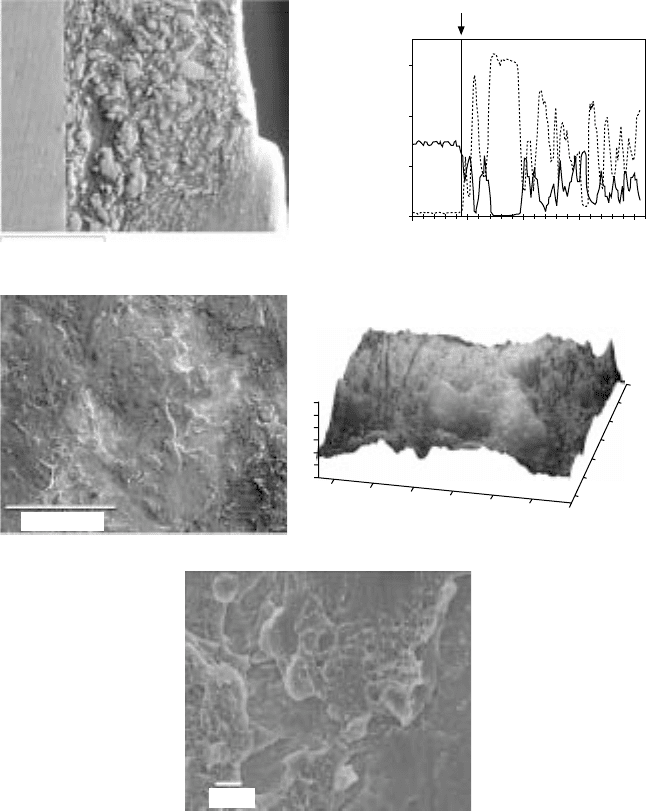
Titanium alloys: modelling of microstructure534
coating at high magnification may provide evidence of the ductile behaviour
of the material during MA processing (Fig. 19.2e).
The thickness of the aluminium coating is about 50 µm, without a clear
interface between the substrate and aluminium layer (Fig. 19.3a,b). The
200 µm
(c)
(d)
µm
1.2
1
0.8
0.6
0.4
0.2
0
µm
30
25
20
15
10
5
0
µm
30
25
20
15
10
5
0
100 µm
(a)
Interface
Ti+Al coating
Substrate
Ti
Al
× 10
3
Intensity of Kα1
3
2
1
0
0 50 100 150 200
µm
(b)
(e)
1 µm
19.2
As-synthesised titanium and aluminium coating produced by
MA method: (a) secondary electron image of cross-section
microstructure; (b) concentration profile; (c) surface microstructure;
(d) morphology; (e) dimple structure.
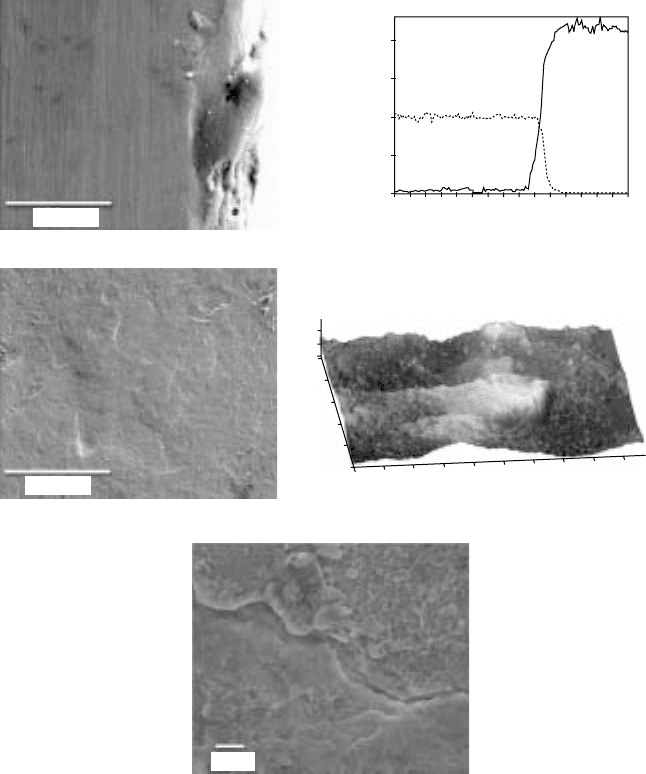
Aluminising: fabrication of Al and Ti–Al coatings by mechanical 535
coating is continuous and very dense (Fig. 19.3c). The surface of the aluminium
coating is flatter and more homogenous than that of the titanium/aluminium
coating (Fig. 19.2). The morphology is again similar to a fracture surface
(Fig. 19.3d). The dimple structure and microcracks in some areas of the
aluminium coating at high magnification are observed (Fig. 19.3e). The
µm
1.2
0.6
0
µm
50
40
30
20
10
0
0 5 10 15 20 25 30 35 40 45
µm
(d)
200 µm
(c)
1 µm
(e)
0 50 100 150
µm
(b)
Intensity of Kα1
Al coating
Substrate
Ti
Al
× 10
3
2
1.5
1
0.5
0
100 µm
(a)
19.3
As-synthesised aluminium coating produced by MA method: (a)
secondary electron image of cross-section microstructure; (b)
concentration profile; (c) surface microstructure; (d) morphology; (e)
dimple structure.
Titanium alloys: modelling of microstructure536
absolute amount of aluminium in the titanium/aluminium coating is more
than that in the aluminium coating because the former is thicker.
During MA processing, aluminium is better deposited on the surface in
the presence of titanium particles. The microstructure of the coating surface
provides evidence of ductile behaviour of the material during MA (Figs. 19.2
and 19.3). This behaviour would indicate that the local temperature under
the ball impacts is higher than the temperature of the chamber walls. The
stress generated during MA may be rather high as well (Suryanarayana,
2001). The titanium particles are in the aluminium matrix (Fig. 19.2a). Titanium
appears as a dispersive material and aluminium serves as a bonding one.
Cold welding between particles and substrate under repeated ball collisions
leads to the formation of a composite coating. Aluminium flows into the
pores between the titanium particles under the impact of the balls. As a
result, a dense titanium and aluminium coating grows. Cold welding occurs
non-uniformly. Therefore, a very rough surface on the titanium/aluminium
coating is formed (Figs. 19.1 and 19.2c). In the case of using the powder of
pure aluminium, an aluminium layer with some thickness is coated, but
extensive cold welding between aluminium particles and the aluminium layer
cannot happen. Cold welding may occur in the early stages of MA, when the
aluminium particles are soft, and their tendency to weld is high. Under
deformation, the particles and the aluminium layer become harder and more
brittle (Suryanarayana, 2001). This is confirmed by the microcrack in Fig.
19.3d. With increase of MA-time, cold welding is restrained. Under the ball
collisions, the aluminium coating starts flaking and becomes smoother in
comparison with the titanium/aluminium one (Figs. 19.1, 19.2 and 19.3). In
the case of the titanium/aluminium coating, alloying may occur rapidly in
the presence of titanium particles. There is no time for the coating to become
brittle.
19.3 Annealing treatment of aluminium coating
Table 19.1 summarises the phase composition, without including the phases
of the substrate, α-Ti and β-Ti. During annealing, on the surface of the
sample different aluminide phases are formed as the result of interdiffusion
and reaction between titanium and aluminium. Aluminium reacts with titanium
on heating up to 600 °C, and forms Al
3
Ti. No diffraction peaks of pure
aluminium are in the X-ray pattern (Fig. 19.4a), but it completely reacts on
the formation of Al
3
Ti.
The contrast difference in Fig. 19.5a, a back-scattered electron image,
reflects different compositions. On heating up to 600 °C, aluminium diffuses
into the substrate. The grey dark layer from the start of the substrate is
enriched by aluminium (Fig. 19.5b). The thickness of the diffusion layer is
about 80 µm. The coating itself becomes porous after annealing treatment at
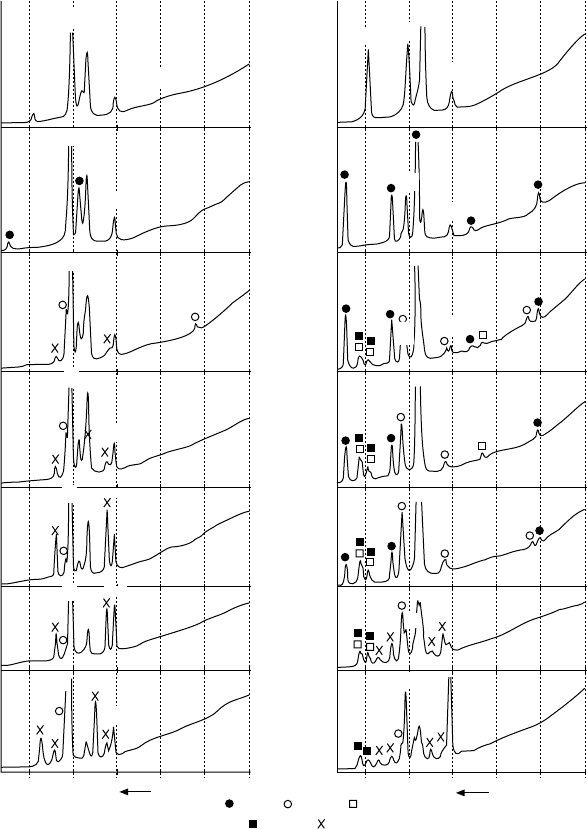
Aluminising: fabrication of Al and Ti–Al coatings by mechanical 537
600 °C, with microcracks between substrate and coating (Fig. 19.5a). The
coating surface is porous and rough as well. Upon heating up to 600 °C, pits
are formed on the surface (Fig. 19.5c).
A second anneal at 700 °C after annealing treatment at 600 °C leads to the
formation of Ti
3
Al on the surface (Table 19.1 and Fig. 19.4a). In addition,
Intensity (rel. un.)
(a) Al coating (b) Ti+Al coating
Al
αTi
αTi
αTi
Al
αTi
βTi
αTi
αTi
αTi
βTi
αTi
d=2.15
d=2.48
αTi
βTi
αTi
d=2.15
d=2.48
αTi
αTi
αTi
βTi
d=2.15
d=2.48
αTi
αTi
αTi
d=2.15
d=2.48
d=2.40
d=2.48
αTi
αTi
αTi
d=2.15
d=2.08
2θ (deg.)
45 40 35 30 25 20 45 40 35 30 25 20
2θ (deg.)
Al
3
Ti Ti
3
Al Al
2
Ti
TiAl
-phase
as-synthesised
annealing
T=600 °C
T=700 °C
T=800 °C
T=900 °C
T=1000 °C
T=1100 °C
as-synthesised
annealing
T=600 °C
T=700 °C
T=800 °C
T=900 °C
T=1000 °C
T=1100 °C
Al
αTi
αTi
αTi
Al
αTi
αTi
αTi
αTi
αTi
αTi
αTi
d=2.08
d=2.40
d=2.48
αTi
αTi
d=2.15
d=2.08
d=2.40
d=2.48
d=2.15
Intensity (rel. un.)
βTi
19.4
X-ray diffraction patterns (CuK
α
) of MA-coatings after annealing
at temperatures ranging between 600 and 1100 °C: (a) aluminium
coating; (b) titanium/aluminium coating.
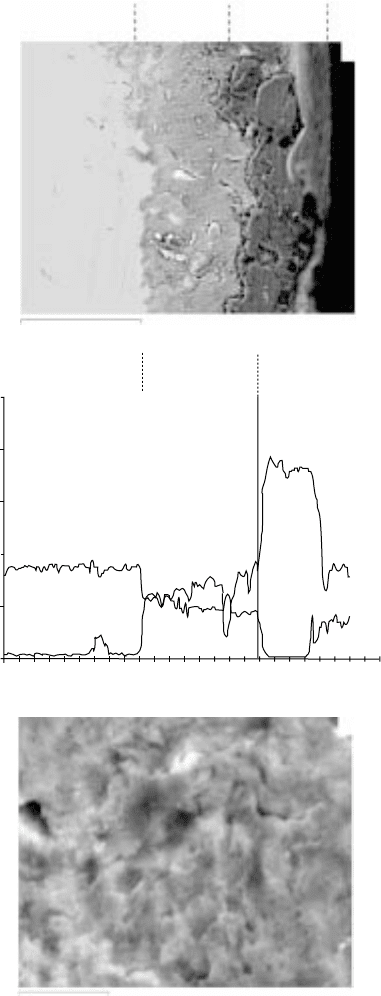
Titanium alloys: modelling of microstructure538
Substrate
Start of
substrate
Coating
Substrate
Al coating
Ti
Al
0 50 100 150 200 250
µm
Intensity of Kα1
2.5
2
1.5
1
0.5
0
×10
3
(b)
19.5
Aluminium coating after annealing at 600 °C: (a) back-scattered
electron image showing cross-section microstructure;
(b) concentration profile; (c) surface microstructure.
10 µm
(c)
100 µm
Substrate
Start of
substrate
Coating
(a)

Aluminising: fabrication of Al and Ti–Al coatings by mechanical 539
new diffraction lines with d = 2.48 and 2.15 Å are in the X-ray pattern (Fig.
19.4a). In Table 19.1 and Fig. 19.4, this phase is denoted as X-phase. After
subsequent increase of the annealing temperature from 700 to 1000 °C, the
intensity of the X-phase diffraction lines increases while the intensity of the
Ti
3
Al ones decreases. Increase of annealing temperature increases the volume
fraction of X-phase at the expense of Ti
3
Al. After annealing treatment at
1100 °C, only slight asymmetry of the α-Ti diffraction peaks at the high-
angle side may indicate the presence of the Ti
3
Al phase (Fig. 19.4a). The
intensity of the X-phase lines with d = 2.48 and 2.15 Å considerably decreases
after annealing at 1100 °C, in comparison with treatment at 1000 °C, while
the other strong peaks with d = 2.40 and 2.08 Å appear in the X-ray diffraction
pattern (Fig. 19.4a).
The lines with d = 2.48 and 2.15 Å could be attributed to TiC, and the
ones with d = 2.40 and 2.08 Å could be attributed to Ti
3
AlC. The above
sequence of peaks appearing means that Ti
3
AlC could be formed from TiC
(Zhou et al., 2003). Formation of carbide phases during annealing treatments
can be due to carbon contamination of the coating during MA. The X-phase
completely disappears after the elimination of the aluminised layer.
Moreover, formation of Al
2
Ti and TiAl compounds on the titanium surface
coated by the aluminium film precedes formation of Ti
3
Al (Romankov et al.,
2006, 2007). In the case of the aluminium coating produced by MA, Al
2
Ti
and TiAl phases are not present. This can be a result of the stress and
structural features of MA-coating. During MA processing, the substrate surface
and coating are plastically deformed, leading to grain refinement into the
nanometre scale and an extremely high density of dislocations (Wang et al.,
2003). The large amount of grain boundaries and defects may provide rapid
atomic diffusion in the surface layers. As a result, diffusion transformation
on the substrate with the aluminium coating produced by MA can occur very
fast, and Al
2
Ti and TiAl phases will not remain after 2 hours annealing.
These phases may be skipped altogether. Defect structure formed during MA
processing can have a great effect on the thermodynamics of the interdiffusion
process.
Table 19.1
The principal temperature ranges of the aluminide phase formation and
the phase composition on Ti-4%Al-3%Mo-1%V alloy of the mechanical alloying
deposited coatings
Temperature (°C) Aluminium coating Titanium/aluminium coating
600 Al
3
Ti Al
3
Ti
700–900 Ti
3
Al, X-phase Al
3
Ti, Al
2
Ti, TiAl, Ti
3
Al
1000 Ti
3
Al, X-phase Al
2
Ti, TiAl, Ti
3
Al, X-phase
1100 Ti
3
Al (trace), X-phase TiAl, Ti
3
Al, X-phase

Titanium alloys: modelling of microstructure540
With an increase of annealing temperature, a gradual levelling of coating
happens (Fig. 19.6a,b). Annealing at 1000 °C gives a homogeneous and even
microstructure on the aluminium coating (Fig. 19.6b). In the high magnification
micrograph of the aluminium coating, micropits are present after annealing
(a) (b)
(c) (d)
200 µm 200 µm
10 µm 10 µm
10 µm
(e) (f)
µm
4.5
3
1.5
0
µm
30
25
20
15
10
5
0
µm
30
25
20
15
10
5
0
19.6
Surface microstructural evolution of aluminium coating during
annealing treatments: (a) 800 °C; (b) 1000 °C; (c) 900 °C; (d) 1000 °C;
(e) 1100 °C; (f) morphology after 1100 °C.
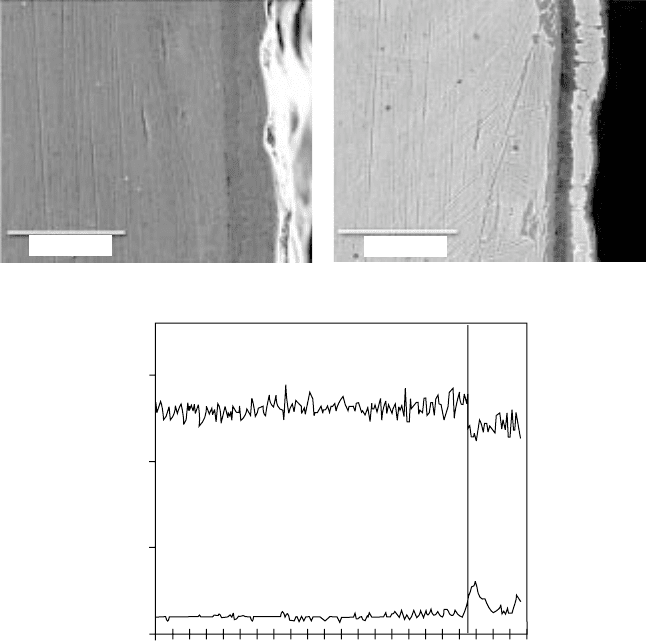
Aluminising: fabrication of Al and Ti–Al coatings by mechanical 541
at 900 °C. The sizes of the micropits increase, and the coating becomes
porous as the annealing temperature rises to 1000 °C (Fig. 19.6c,d). With
subsequent increase of temperature up to 1100 °C, the coating structure
coalesces (Fig. 19.6e), and the surface morphology becomes flat (Fig. 19.6f).
Thus, the annealing treatment results in the gradual levelling of the MA-
coating surface, which is very rough in the as-synthesised condition (Fig.
19.3d).
After annealing at 1100 °C, the MA-coating itself shows a structure with
high apparent density (Fig. 19.7a). However, there are some pores and peeling
in some areas along the coating/substrate interface (Fig. 19.7a,b). Figure
19.7b shows a different composition of aluminium coating. The jump in
0 50 100 150 200 µm
(c)
Al
coating
Substrate
Ti
Al
×10
3
Intensity of Kα1
1.5
1
0.5
0
100 µm
(a)
100 µm
(b)
19.7
Cross-section microstructure of aluminium coating after
annealing at 1100 °C: (a) secondary electron image; (b) back-
scattered electron image; (c) concentration profile.
Titanium alloys: modelling of microstructure542
aluminium concentration is at the interface (Fig. 19.7c), consistent with the
clear contrast in the back-scattered electron image (Fig. 19.7b). The diffusion
layer in the coating adjacent to the substrate is formed. The substrate itself
has a coarse grain lamellar structure. The concentration of aluminium in the
near surface region of the substrate is about 16 at.% after annealing at 1100
°C, twice the aluminium concentration in the substrate.
Thus, significant changes in the structure of the aluminium coating occur
after annealing at temperatures above 800 °C. At about 880 °C, α-Ti (hcp)
to β-Ti (bcc) transformation in the substrate should occur. The intense
interdiffusion between substrate and coating leads to recrystallisation of the
coating structure. Moreover, at temperatures exceeding 900 °C, the growth
of β-grains in the substrate occur. The concentration of aluminium at the
near-interface region increases significantly upon heating. As a result, α-Ti
to β-Ti transformation in the substrate and near-surface region of the substrate
does not occur simultaneously. Annealing at temperatures above 900 °C
leads to recrystallisation of the near-surface region and stabilising α-Ti at
the interface. Then, the lines of β-phase are not in the X-ray diffraction
patterns of the aluminium coating after annealing treatment above 900 °C
(Fig. 19.4a).
19.4 Annealing treatment of the
titanium/aluminium coating
Annealing of titanium/aluminium coatings at 600 °C induces the formation
of Al
3
Ti (Table 19.1 and Fig. 19.4b). Aluminium completely reacts on the
formation of Al
3
Ti. The peaks of α-Ti are in the X-ray diffraction pattern
after annealing at 600 °C (Fig. 19.4b), showing that particles of pure titanium
are present in the coating. The coating is porous (Fig. 19.8a), consisting of
non-uniform particles. A layer with a thickness of about 12 µm from the start
of the substrate is enriched by aluminium (Fig. 19.8b). However, in comparison
with the aluminium coating, the diffusion layer is substantially thinner (Fig.
19.5a,b). After annealing at 600 °C, the surface microstructure of the titanium/
aluminium coating is porous and rough, along with the formation of very
fine particles on the surface (Fig. 19.8c). A comparison of the two types of
coatings might indicate that in the case of the aluminium coating, formation
of Al
3
Ti results from interdiffusion between the titanium substrate and the
aluminium layer. In the case of the titanium/aluminium coating, Al
3
Ti is
formed mainly as a result of reaction between titanium particles and the
aluminium matrix in the coating, which also leads to the porosity.
Annealing the titanium/aluminium coating at 700 °C reduces the intensity
of the Al
3
Ti and α-Ti diffraction peaks in the X-ray pattern (Fig. 19.4b).
Ti
3
Al lines along with the wide asymmetric peaks of the Al
2
Ti phase are
present. The Al
2
Ti and TiAl compounds have close lattice plane spacing.
